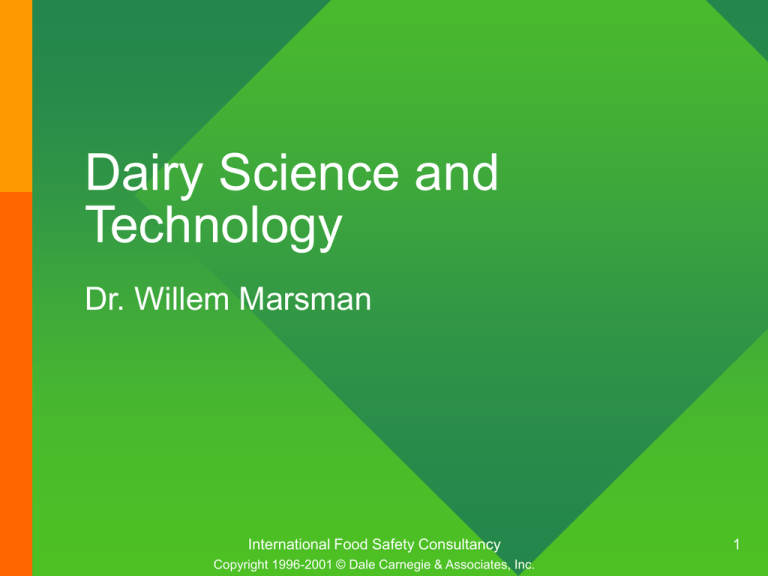Dairy Science and Technology
advertisement

Dairy Science and Technology Dr. Willem Marsman International Food Safety Consultancy Copyright 1996-2001 © Dale Carnegie & Associates, Inc. 1 introduction • It focuses on the biological, physical and microbiological aspects of milk itself and on the technological (processing )aspects of the transformation of milk into its various consumer products including beverages, fermented products, concentrated and dried products, butter and ice-cream International Food Safety Consultancy 2 continue • Milk is ancient as man kind itself as it is the substance created to feed mammalian infant • Many centuries ago ancient man learned to domesticate species for the provision of milk to be consumed by them • Fermented products such as cheese were discovered by accident but their history has also been documented for many centuries as has the production of concentrated milk, butter and even ice cream International Food Safety Consultancy 3 continue • The role of milk in nature is to nourish and provide immunological protection for the mammalian young. Milk and honey are the only articles of diet whose sole function in nature is food International Food Safety Consultancy 4 Milk production and biosynthesis • Milk is the source of nutrients and immunological protection for the young cow • Gestation for the female cow is 9 month • At parturition fluid from the mammary gland known as colostrum is secreted-is yellowish colored, salty liquid has a very high serum protein content and provides antibodies to help the newborn until its own immune system is established • Within 2 hours the composition of colostrums returns to that of fresh milk allowing to be used in food supply International Food Safety Consultancy 5 continue • The period of lactation then continues for an average of 305 days producing 7000 kg of milk. This is quite a large amount considering the calf only needs about 1000 kg for growth. • The highest yields is 2-3 months post parturition yielding 40-50 l/day • a cow reaches a peak in production about her third lactation but can be kept in production for 5-6 lactations if the yield is still good International Food Safety Consultancy 6 continue • About 1-2 months after calving the cow begins to come into heat again. She is usually inseminated about 3 months after calving so as to come into a yearly calving cycle • Heifers are normally first inseminated at 15 months so she is 2 years when the first calf is born . • About 60 days before the next calving the cow is dried off International Food Safety Consultancy 7 Effects of milk handling on quality and hygiene • Cleanliness: • The environment of production has a great effect on the quality of milk produced from the food science perspective the production of the highest milk should be the goal, however this is not always the greatest concern of those involved in milk production International Food Safety Consultancy 8 • Hygienic quality assessment test include: 1. Sensory test 2. Dye reduction test for microbial activity 3. Total bacterial count (standard plate count) 4. Sediment 5. Titratable acidity 6. Somatic cell count, 7. antibiotic residues and 8. added water International Food Safety Consultancy 9 continue • The two common dye reduction tests are: • Methylene blue and reazurin, as part of natural metabolism active micro organisms transfer electrons and thus rate at which dyes added to milk are reduced is an indication of the level of microbial activity: • Methylen blue turns from blue to colorless • While resazurin turns from blue to violet to pink to colorless • The reduction time is inversely correlated to bacterial numbers International Food Safety Consultancy 10 Effects of milk handling on quality and hygiene • Temperature: • Following chart 1. 5 degree Celsius-numbers of bacteria per milliliter of milk after 24 hours-2.600 2. 10 Celsius:11.600 3. 20 Celsius: 450.000 International Food Safety Consultancy 11 Effects of milk handling on quality and hygiene • Mastitis and antibiotics; • Mastitis is a bacterial and yeast infection of udder: 1. Lactose content decreased 2. Na and Cl level increased 3. Increase in bacterial numbers-possible human pathogen 4. Increase in somatic cells (leukocytes and epithelial cells) • Clinical mastitis pus can be observed, sub clinical level mastitis is not obvious International Food Safety Consultancy 12 continue • Presence of antibiotic residues in milk is very problematic: 1. Residues can slow or destroy the growth of fermentation bacteria 2. Some human allergic for specific antibiotic 3. Low level antibiotics can cause micro organism to become resistant through mutation International Food Safety Consultancy 13 Effects of milk handling on quality and hygiene • Anti microbial systems in raw milk-natural: • Lysozyme- enzym that’s hydrolyses glycosidic bonds in gram positive cell walls • Lacto ferrin –an iron binding protein that sequesters iron from micro organisms thus taking away one of growth factors International Food Safety Consultancy 14 continue • Lactoperoxidase - an enzyme naturally present in raw milk that catalyzes the conversion of hydrogen peroxide to water. When hydrogen peroxide and thiocyanate are added to raw milk, the thiocynate is oxidized by the enzyme/hydrogen peroxide complex producing bacteriostatic compounds that inhibit gram negative bacteria, E.coli, Salmonella spp, and streptococci (means of increasing the self life of raw milk) International Food Safety Consultancy 15 Milk bio synthesis • Milk is synthesized in the mammary gland • Within the mammary gland is the milk producing unit, the alveolus. It contains a single layer of epithelial secretory cells surrounding a central storage area called the lumen International Food Safety Consultancy 16 continue • The raw materials for milk production are transported via the blood stream to the secretory cells. It takes 400-800 liter of blood to deliver components for 1 liter of milk International Food Safety Consultancy 17 continue • Protein • Lipids • Lactose International Food Safety Consultancy 18 continue • Milking stimuli such as a suckling calf ,a warm wash cloth, the regime of parlor etc., causes the release of a hormone called oxytocine • Oxytocine is released from the pituitary gland, below the brain to begin the process of milk let down International Food Safety Consultancy 19 Milk grading and defects • Milk grading; • The sense of taste, there are four different types of nerve ending on the tongue which detect sweet ,salt ,sour and bitter • The sense of smell • Milk grading techniques , temperature should be 15.5-21 Celsius ,need of representative sample (mixing and agitation), take a generous sip, notice after taste (breath of fresh air) International Food Safety Consultancy 20 Flavor defects International Food Safety Consultancy 21






